Chaperones fold Rubisco
Turbo plants harness more energy
For this reason, scientists are working on developing ways to make photosynthesis more effective. Their aim is to optimize various steps in the process of the conversion of light energy into chemical energy, for example by increasing the efficiency of the photosynthesis machinery.

Plants that have been upgraded in this way would be capable of forming more biomass for the purpose of fuel production. In contrast to this, some scientists want to dispense with plants altogether and equip bacteria with an optimized photosynthesis device instead. Another possible approach will be independent of the services of any kind of organism: hydrogen, for example, could be generated in bioreactors in which photosynthesis takes place using just a few necessary proteins. Nature has, in fact, created enzymes that can split water with the help of solar energy and that could thus replace costly platinum in fuel cells. And nature also has enzymes that subsequently produce hydrogen from the water fragments (see MAXPLANCKRESEARCH 3/2006, page 32 ff.).
At the Max Planck Institute of Biochemistry in Martinsried, near Munich, researchers are looking for a way to make plant photosynthesis more effective – and have already made significant progress toward achieving this objective. The scientists working with Manajit Hayer-Hartl have discovered the folding process of a key protein in photosynthesis, known as Rubisco. Armed with this knowledge, the researchers can now work on finding a way to produce Rubisco artificially and modifying it so that it works more efficiently.
Rubisco is not only the most common protein on Earth, it is also one of the most important. Without Rubisco, life would simply not exist in its current form. It binds carbon dioxide from the atmosphere and brings about its conversion to sugar and oxygen. However, Rubisco works very slowly and ineffectively. It reacts not only with carbon dioxide, but also with oxygen: on average, it binds one oxygen molecule after three to five carbon dioxide molecules. “When Rubisco emerged around four billion years ago, this was irrelevant, as there was not yet any oxygen in the atmosphere. Today, however, the amount of oxygen in the air is around 20 percent,” says Manajit Hayer-Hartl, who is carrying out research on Rubisco with her husband Ulrich. Rubisco could, therefore, work far more effectively if it no longer reacted with oxygen.












